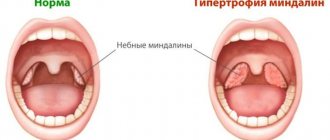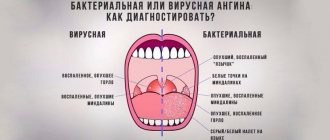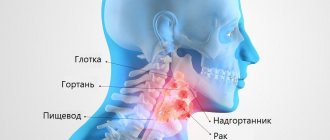Causes
Diseases of the throat and larynx can have various causes. The most common of them:
- viral infection caused by adeno-, rhino-, enterovirus, pathogens of influenza, mumps, parotitis, Epstein-Barr and Coxsackie virus;
- a bacterial infection caused by streptococci, diphtheria pathogens, staphylococci, less commonly gonococci, chlamydia and other microorganisms;
- the effect of toxic or irritating substances - cigarette smoke, exhaust gases, chemical products, soot;
- allergic reaction, cough, sinusitis, gastroesophageal reflux;
- trauma or foreign body penetration, as well as excessive vocal strain.
Treatment of diseases of the throat and larynx should be entrusted to a specialist - an ENT doctor. Correct determination of the cause of the disease is one of the main conditions for recovery.
Causes of enlarged tonsils in children
The increase is caused by the following infectious agents: pneumococci, staphylococci, herpes, streptococci, chlamydia, Haemophilus influenzae, adenovirus, influenza virus. They can be located in the lacunae of the tonsils without manifesting themselves in any way (for example, remain after treatment for a disease), but at a favorable moment they begin to actively multiply and cause an enlargement of the organ. Such triggers can be:
- decreased immunity;
- allergies;
- bad ecology;
- hormonal disorders;
- severe hypothermia;
- lack of vitamins;
- infections.
Main symptoms
Diseases of the throat and other ENT organs are accompanied by the following symptoms:
- pain when swallowing (angina, pharyngitis, laryngitis, foreign body, tuberculosis, tumor);
- sensation of a lump in the throat (tumor, enlarged tonsils, pharyngeal diverticula, gastroesophageal reflux);
- difficulty breathing (angina, paratonsillitis, tumor, abscess, laryngitis, foreign body, diphtheria, Quincke's edema, tuberculosis);
- voice change (trauma, laryngitis, diphtheria, tuberculosis, tumor);
- swallowing disorders (pharyngitis, foreign body, tumor, pharyngeal diverticula).
Symptoms and treatment of diseases of the ENT organs require consultation with a qualified otolaryngologist who is proficient in modern diagnostic methods. Delay in seeing a doctor leads to the development of severe forms of diseases of the throat and larynx.
What does throat cancer look like: photos and pictures
For a more detailed understanding of the localization of throat cancer and the extent of its invasion into nearby organs, the tumor is usually characterized by stages:
- Stage I – asymptomatic, vocal and swallowing functions are not impaired, the tumor is discovered by chance at a routine appointment with an otolaryngologist, measuring 2–3 cm;
- Stage II is the stage of intensive tumor growth and its spread to nearby areas of the larynx. A characteristic clinical picture appears (cough, shortness of breath, change in voice, etc.). Surgical treatment at this stage consists of partial or complete resection of the larynx followed by plastic surgery;
- Stage III – metastasis, tumor growth into all layers of the larynx and complete loss of vocal cord function. As a rule, surgery at this stage does not give good results, so radiation and/or chemotherapy is added to therapy;
- Stage IV – dissemination of metastases to target organs (lungs, brain). Treatment is palliative only.
Photo of the larynx 1. Cancer of the larynx in the glottis area
Photo of the larynx 2. Stages of throat cancer (I – III)
Most common diseases
The most common diseases of the throat (pharynx) are:
- Acute and chronic pharyngitis
An inflammatory process in the pharynx, accompanied by sore throat, sore throat, and difficulty swallowing. It is caused by a viral or, less commonly, bacterial infection. The treatment uses antibiotics and local therapy - irrigation, rinsing, lozenges and lozenges with antiseptic, anti-inflammatory and analgesic effects.
- Damage from foreign bodies and burns from acids, alkalis, and household chemicals
These conditions require emergency medical attention. Foreign bodies are removed during laryngoscopy. For chemical burns, pharyngeal irrigation, painkillers, and rehydration therapy are prescribed.
- Benign tumors - papilloma, fibroma, neuroma and others
The main symptom of these diseases is difficulty swallowing. With large formations, compression of the respiratory tract is possible. For differential diagnosis with malignant neoplasms, a biopsy is necessary. Treatment is predominantly surgical.
- Malignant tumors – cancer and sarcoma
The diseases cause bleeding, enlarged lymph nodes, and general intoxication of the body. For an accurate diagnosis, an in-depth examination is necessary - a biopsy, CT or MRI of neck tissue. Treatment is complex, its scope depends on the stage of the tumor. The main method of treatment is surgery in combination with radiation.
Diseases of the larynx, the symptoms and treatment of which require consultation with a doctor:
- Acute and chronic laryngitis
The disease is accompanied by a change in voice and sore throat. The main reason is a viral infection. Treatment is predominantly symptomatic, aimed at relieving inflammation and accelerating the regeneration of damaged tissues. Chronic laryngitis, especially occupational laryngitis, requires treatment by a phoniatrist. Acute laryngitis in children can lead to obstruction of the lumen of the larynx and the development of croup, for example, with diphtheria. This condition is life-threatening for the child.
- Abscess and phlegmon
These are purulent-inflammatory diseases that cause breathing problems, severe sore throat, and signs of intoxication. Pathology can cause narrowing of the airways and suffocation. The main method of treatment is surgical opening of the purulent focus, its drainage and antibiotic therapy.
- Benign tumors - fibromas and papillomas, as well as nodules formed due to excessive vocal load
The main symptom is hoarseness or absence of voice (aphonia). Treatment uses local medications, physiotherapy, and removal of tumors using minimally invasive techniques. A course of treatment is being carried out by a phoniatrist.
- Malignant tumors
These dangerous diseases are accompanied by hoarseness, foreign body sensation, and breathing problems. Subsequently, the tumor affects the nearest lymph nodes, and then distant organs, leading to the appearance of cancer intoxication. When the tumor mass disintegrates, bleeding occurs, which is life-threatening. Treatment is surgical, in combination with radiation therapy. In the future, rehabilitation aimed at restoring speech function is required.
- Foreign bodies of the larynx
Usually found in young children and can cause respiratory arrest. Require immediate medical attention with laryngoscopy.
Diseases of the larynx and pharynx can also be associated with tuberculosis or syphilitic lesions, fungal diseases, an allergic reaction, or direct injury to the neck. In all these cases, a thorough diagnosis of the cause of the pathology and treatment according to modern standards is necessary.
How is inflammation treated?
The tactics for treating enlarged tonsils in a child consists of treating the underlying disease that caused this symptom (taking antibiotics, antiviral or antifungal drugs), and influencing them directly to regenerate the affected tissues. The latter includes:
- washing the tonsils from pathogenic microorganisms and mucus with antiseptic solutions;
- reducing swelling - taking antihistamines and ultraviolet irradiation;
- UHF therapy, which improves blood microcirculation;
- exposure to ultrasound to free the lacunae of the tonsils from pus, which can accumulate in them;
- laser exposure to destroy infection and its pathogens.
Diagnostics
To diagnose diseases of the throat and larynx, doctors use the following instrumental diagnostic methods:
- pharyngoscopy, which includes examination of all parts of the pharynx using a nasopharyngeal or laryngeal mirror, as well as a special device - an epipharyngoscope;
- laryngoscopy – examination of the larynx using mirrors;
- microlaryngoscopy - direct examination of the walls of the larynx using a microscope;
- fiberoscopy - examination of the larynx using a fiber optic apparatus; During the procedure, you can remove a small foreign body or take a biopsy;
- radiography and computed tomography, including contrast, useful for identifying stenoses, malformations, tumors;
- Magnetic resonance imaging is a safe study, especially informative for soft tissue pathologies, including tumors.
The truth about red throat
When a doctor tells you during an examination that the child’s throat is red, be sure to clarify what exactly is red there, because the structure of the oral cavity consists of several structures:
- solid sky
- soft sky
- palatine arches
- tongue
- tonsils
- posterior wall of the pharynx
- gums
- mucous membrane of lips and cheeks
- language
Red throat and red throat are different. See for yourself: the baby screamed or cried, the throat, or rather the soft palate, palatine arches, and the back wall of the throat turned red. The air is dry in the house - the color is red again. It’s stuffy or smoky in the room – it’s red again. The child sucked the lollipop and his throat turned red again. I coughed when I choked and my throat was already red.
It is important to take into account the condition of the child in the presence of a “red throat”. If the baby is active, has a normal temperature of up to 37.5, maintains his appetite and drinks enough fluids, then this is not a disease.
As a rule, if a child’s throat really bothers him or hurts, then the baby swallows with difficulty and tries not to do this again so as not to hurt. The child will refuse food and drinks.
Also be sure to watch the doctor examine your throat, usually using a flashlight. Let's not forget that everyone's eye is different and so is their perception of color. To some, the color of the mucous membranes will seem bright red, to others normal, to others even blue. Therefore, it is important to carry out diagnostics using a flashlight, since without it it will be very difficult to determine the degree of redness.
But despite these circumstances, we should not forget that redness of the oral mucosa is also the body’s response to an infection entering it. That is, a red throat, in the presence of other symptoms, is a symptom of an infectious disease in the body.
Treating a sore throat if necessary
Treatment for throat diseases depends on the diagnosis.
A viral throat (usually pharyngitis) does not require antibacterial drugs. It is enough to rinse with medicinal herbs and antiseptics.
Inhalations with alkaline solutions give good results.
The patient is also recommended tablet antiviral therapy.
Herpetic sore throat, like pharyngitis, is treated with antiviral drugs; antibiotics can only aggravate this disease. The treatment regimen includes antipyretics, antihistamines, vitamins and immunomodulators.
For sore throat and tonsillitis, antibacterial treatment cannot be avoided, and it must be carried out in a timely manner. Purulent plaque spreads very quickly, therefore, complications from other organs cannot be allowed. Typically, the treatment process begins with penicillins; if they are ineffective, they resort to macrolides or cephalosporins.
Fungal infections of the throat are often observed after long-term antibiotic therapy. To get rid of candidiasis, antimycotic and antiseptic agents are used. Irrigation, rinsing, dissolving tablets and lubricating with solutions are prescribed. It is possible to quickly cure a fungal infection, provided that all the specialist’s instructions are strictly followed.
Important! It is strictly forbidden to carry out independent antibacterial treatment. Unfortunately, many citizens attribute antibiotics to themselves without any justification, explaining their actions in order to prevent complications at all costs.
Chronic tonsillitis in a child: treatment methods
This disease is diagnosed in children if inflammation of the tonsils occurs more than twice a year. In case of chronic disease, the tonsils themselves become a source of infection. The immune system weakens, and the child is often exposed to illness.
Chronic tonsillitis should be treated by an experienced otolaryngologist. Some ENT doctors recommend removing the tonsils immediately. But you need to remember, by removing the tonsils, you lose the body’s natural defenses against bacteria and viruses forever!
At the ENT Clinic of Doctor Zaitsev, we treat chronic tonsillitis, and we resort to removal of the tonsils only in the most extreme cases, when conservative treatment methods have been completely exhausted.
The procedures for ultrasonic medicinal irrigation of the tonsils using the “Tonsillor” apparatus (it can be seen in the photo) have a good therapeutic effect. Our clinic also has a unique vacuum attachment for this device, which has no analogues in other medical institutions. This attachment is painless, safe and can be used to treat children starting from school age.
Tonsils on guard
The tonsils (or tonsils) are located on both sides of the throat. All bacteria and viruses that enter the body through the mouth are encountered first. Externally, the tonsils have a porous structure; this structure helps them “examine” all the substances that enter the body and decide what to do with them. In the thickness of the palatine tonsils there are special depressions - lacunae, and the convoluted channels in the thickness of the tonsils are called crypts; they are difficult to see in a photo or with the naked eye. There are also target cells that act as “traps” for microorganisms. When it comes into contact with them, the tonsil decides whether to fight them or not, whether they will cause harm to a person or whether they will be harmless.
When a person is healthy and his tonsils are strong, when any infection enters the body, they begin to actively produce white blood cells to fight the infectious pathogen. But when inflammation affects the tonsils themselves, they lose their protective function and themselves become a source of infection. Pathogenic viruses and bacteria settle firmly in the gaps. What function can inflamed tonsils perform? None! As a result, the tonsils fall out of the body's general defense system and there is a high chance of developing chronic tonsillitis in children.
A little anatomy
The pharynx is part of the respiratory tract and digestive tract. It contains a whole complex of lymphoid formations called the Pirogov-Waldeyer pharyngeal ring. The ring includes the palatine, pharyngeal, lingual, tubal tonsils, as well as lymphoid granules and ridges that are located on the lateral walls of the pharynx.
The tissues of the pharynx are penetrated by a huge number of blood vessels. Their superficial location provides warming or cooling of the air inhaled through the mouth and nose. In contact with the mucous membrane, the air is cleared of dust, chemical impurities and various microorganisms. Dust particles, substances and microbes settled on the mucous membrane irritate it, which sometimes causes inflammation and redness of the throat1.
Up to contents
Throat examination
Unfortunately, it is not always possible to examine the throats of loved ones objectively.
For example, while looking down the child’s throat, a mother suddenly sees something “suspicious” and in a panic drags the baby to the pediatrician.
Of course, many people lack medical knowledge, but parents who have two or more children in the family are more likely to gain experience.
And yet, you need to be able to determine whether your throat is healthy or sore, i.e. not to make a diagnosis, but to understand whether the oropharynx is normal or pathological.
To assess the condition of the throat, it is necessary to conduct an examination:
- bring the patient closer to daylight, it is better to find a place near a window, or sit him on a chair and take a flashlight with a bright light bulb. We ask the patient to open his mouth wider and press his tongue so that the entire lumen of the throat is visible. If this maneuver does not work for the patient, it is necessary to use a spatula or a teaspoon to press the tongue. Next, we illuminate the pharynx well and examine all parts of the throat;
- You need to press on the spatula carefully, because... Some patients experience a gag reflex, so the examination procedure must be performed quickly. Do not press the spatula on the root of the tongue; it is enough to press the tongue in its middle part;
- when examining the tonsils, when we need to assess whether there is tonsillitis or tonsillitis, it is enough to stick your tongue forward; there is no need to press it. Using a flashlight, we examine the tonsils for plugs and purulent contents;
- During the examination, the patient must breathe deeply and evenly, this makes it possible to lower the tongue to the lower palate.
- Mucus in the throat with blood - causes and methods of treatment;
- Often, along with the appearance of minor tumors, patients may suffer from soreness;
- - It hurts my throat a lot.
"ENT Clinic of Doctor Zaitsev"
Treatment of tonsillitis in children in Moscow is offered by many medical institutions: from district clinics and multidisciplinary centers to private clinics. The main thing is to make the right choice!
Our clinic accepts patients from the age of three. The ENT clinic has everything necessary for the successful treatment of sore throat and chronic tonsillitis: the most modern equipment and instruments, its own treatment methods, and most importantly, highly qualified ENT specialists with extensive practical experience. A visit to a doctor for a small patient is always stressful, and our task is to make the appointment as calm and easy as possible for the child. The examination takes place in a playful way: the baby no longer perceives the treatment as something scary and unpleasant, and the mother’s saved nerves are worth a lot. Our clinic is equipped with a children's corner where a child can play, read, or just drink tea and cookies while the mother and the doctor discuss the treatment regimen. Prices for our services have not changed for more than three years and remain one of the best in Moscow.
If you have discovered the first signs of a sore throat in your child, or he has been suffering from relapses of chronic tonsillitis for several years, please do not delay and make an appointment. We will help you cope with this illness.










